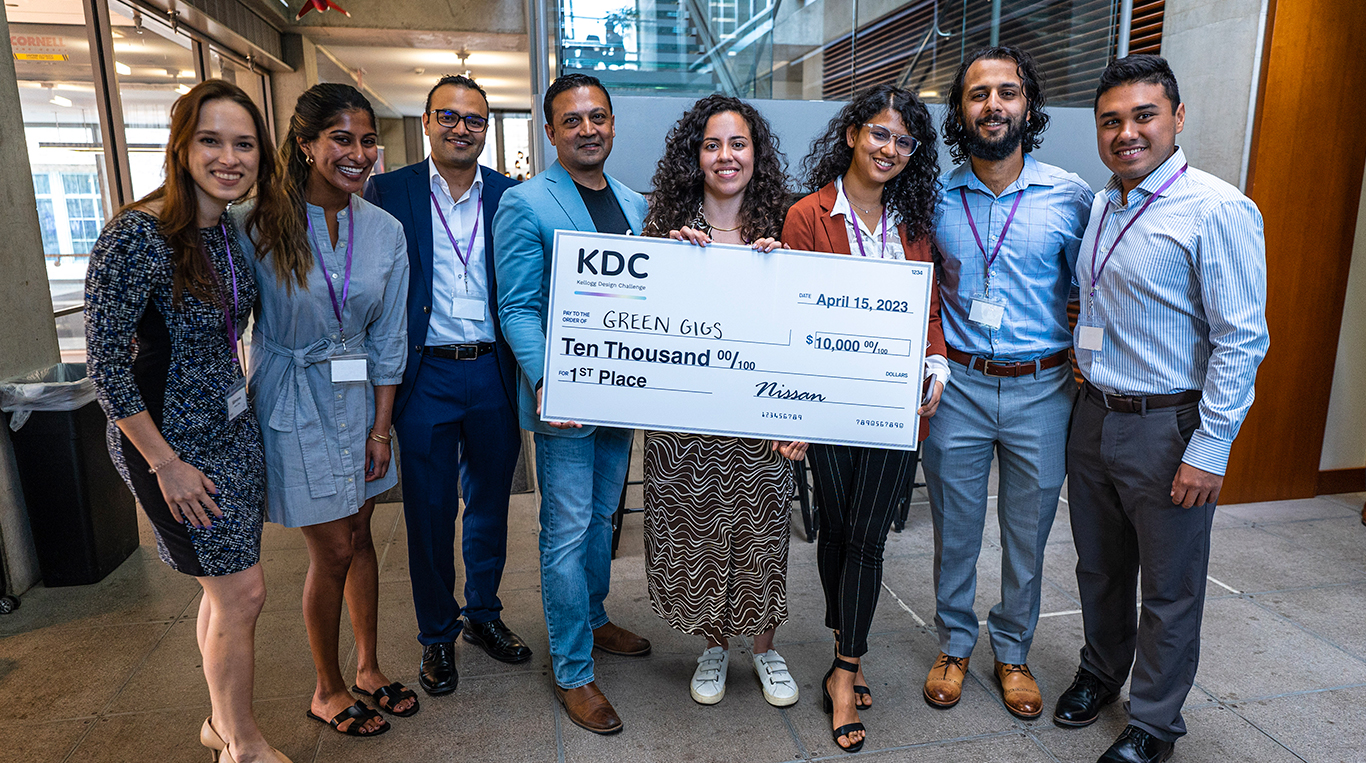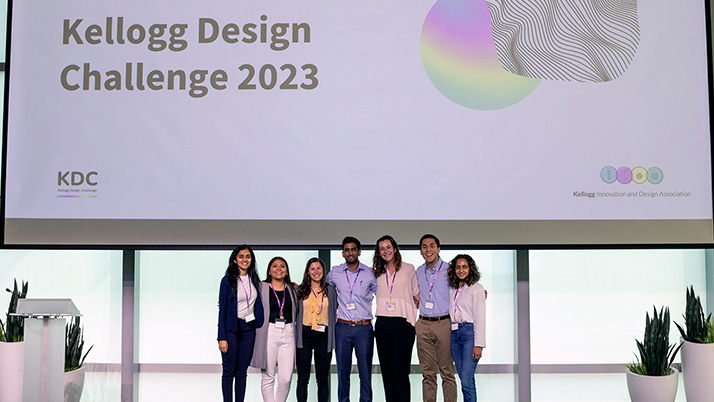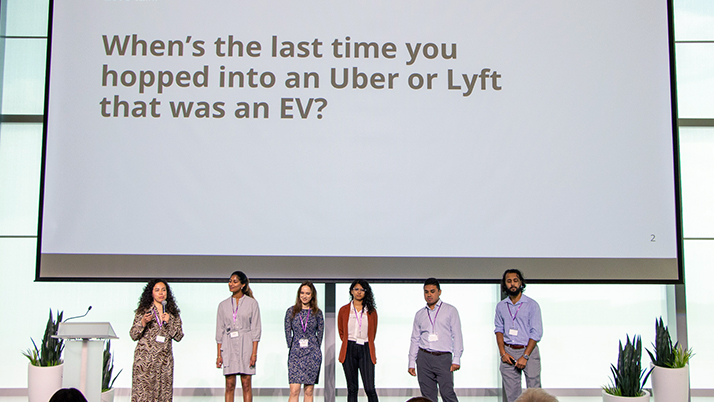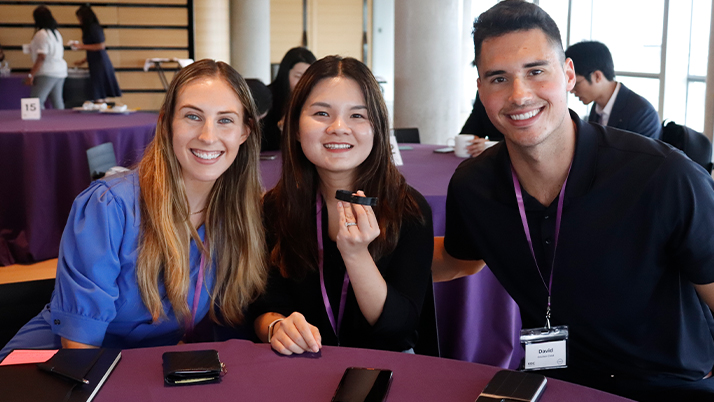Green Gigs victorious at Kellogg Design Challenge

Team members included MMM Program students Geetha Somayajula ’24 and Uday Singh ’24; Two-Year MBA Program student Simone D’Luna ’24; and MBAi Program students Vasudha Khare ’23 MBA, Erika Ortiz ’23 MBA and Kareem Younis ’23 MBA. They were tasked with answering this question: How might Nissan reimagine existing transportation systems to better serve the mobility needs of global users?
Judges included industry professionals, Nissan representatives and faculty from Kellogg and Northwestern's Segal Design Institute. The design challenge also welcomed keynote speakers Christina Mallon, principal director of inclusive design at Microsoft; Steve Schwall, partner at IDEO; and Ponz Pandikuthira, senior vice president and chief product and planning officer at Nissan.
This event was mainly led by Collett Arraj ’23 MBA, Pravallika Karavadi ’23 MBA and Two-Year MBA Program students Karan Saini ’24 and Rujuta Kamat ’24 with additional support from Regan Fiascone ’23 MBA and JV Smriti Sharma. Luis Cerro ’23 MBA, a member of the student organizing team, said that for this year’s business design case competition, they wanted to approach the competition with a lens of sustainability and accessibility. They found that mobility was the perfect space in which participants could design innovations that best serve the needs, pain points and desires of specific user groups — including families, people with disabilities and individuals from rural communities.
Winning team member Singh agreed: “This experience really highlighted the importance of thinking about the “art of the possible” but then also grounding in reality and tactically thinking about how to achieve that vision.”
We spoke with Green Gigs to learn more about their experience competing in the design challenge as well as why they are all so passionate about the topic of sustainability.
What was one of the biggest lessons you learned while participating in the design challenge?
Geetha Somayajula (GS): One of my key takeaways was the importance of thinking beyond product design to also consider how the design of the business itself can create value for the user. In our solution, we created a redesigned EV that was customized to gig workers, but we also developed an inclusive business model and envisioned wrap-around services that elevated the driver’s experience. I’m glad that in MMM we’re encouraged to think about problems holistically and to leave no stone unturned in a user’s journey.
Erika Ortiz (EO): One of the biggest lessons I learned was the power of focusing on the user's needs. By identifying the high cost of owning a vehicle — especially an electric one — as a major pain point, we were able to find innovative solutions that addressed this issue. It highlighted the importance of user-centered design and the potential for innovation within mature industries.
Uday Singh (US): The biggest lesson for me was thinking about “why and how does our recommended solution make sense for Nissan.” While my prior experiences from design consulting and previous MMM coursework focused a lot on user desirability, what differentiated our pitch was the emphasis we put on market sizing, developing a business model to support the product and thinking about how Nissan would be well positioned to successfully launch our recommendation.
Vasudha Khare (VK): Identifying user segments, and interviewing users was a lot of fun — and my biggest learning. Also, our team brainstorming sessions were excellent. Seeing how our idea evolved over time was a very cool process.
Simone D’Luna (SD): A big takeaway for me was to be really clear in defining the customer — and therefore the needs — you want to serve when designing. By focusing on a specific population like gig workers, we were able to go deep in building user empathy and understanding. Through interviews, we learned that gig workers’ pain points were not only with vehicle features but also with the broader system of owning and utilizing their vehicles. Then when it was time to ideate, we had the right system-wide frame to create solutions that addressed those needs.
Kareem Younis (KY): I found that we were able to derive the most value from our interactions with people in our target audience, in our case rideshare drivers. This enabled us to build a user persona by compiling all the different experiences and insights from our various conversations. Having a specific user persona, I learned, is critical to determining how and why we are designing for this kind of individual, allowing us to craft a deliberate story. Matching peoples’ pain points with a product’s value-add features and benefits is key to a successful design.
How was your overall experience participating in the challenge?
GS: I really enjoyed the experience. It was definitely hard work, but I enjoyed working with friends on a meaningful design challenge. On the day of the competition, the organizing team created a fun and engaging environment! I especially enjoyed speakers from IDEO and Microsoft who spoke to us about inclusive design and human-centered transportation. It was also a blast to meet MBA students from other schools around the country. For those who are considering doing KDC next year, I highly recommend the experience!
KY: My experience was absolutely terrific! This was my first exposure to the world of innovation design, and I learned a lot from my MMM peers. The programming and inspiring talks during the day of the challenge were particularly amazing. I was really touched with some of the learnings from the event, such as how Microsoft is revolutionizing the gaming industry by providing accessibility features to those with physical disabilities.
How do you plan to apply these experiences to your coursework or career?
GS: I’m interning with PwC’s Customer Strategy & Experience team this summer, and I will be working on design and innovation-related projects. I know going through the design thinking process, conducting ethnographic research and developing creative solutions as a team will be directly applicable to my role. I’m glad that I got to further develop and refine these skills through KDC!
EO: My experience in the Kellogg Design Challenge has prepared me to prioritize the end user and be their advocate. This mindset will directly influence my coursework and internship at Adobe where I will strive to create user-centric designs and contribute to the development of impactful products.
KY: During my consulting internship at Deloitte, I hope to bring tangible value to my team by always having a design-centric mindset since at the end of the day clients want to have the ability to visualize what our recommendations will look like in reality.
VK: As a PM at Intuit, I hope to facilitate as many brainstorming sessions as possible because I know that the ideation that comes from it is excellent.
You’ve said the diversity of your team helped make you stronger. How so?
GS: I think the diversity of our team was our biggest strength. In addition to the diversity of programs, we also represent four different countries, and we all come from different professional backgrounds. While I leaned in on the ethnography and storytelling parts of the presentation (in true MMM fashion!), Uday provided rigor on the opportunity sizing and business case development. Simone is a start-up maven and former consultant and developed our main persona and coached us all on developing a pithy presentation. Erika and Vasudha were instrumental in conducting primary and secondary research and brought their technical prowess to brainstorming futuristic features for our redesigned EV. Kareem is a proclaimed “Nissan guy,” (he can name literally every Nissan model!) and he brought helpful background and ensured our solution was mapped to Nissan’s core competencies.
Why was this topic important to you personally?
GS: Before Kellogg, I spent a few years living in Visakhapatnam, India, and Los Angeles. Both cities are densely populated and have severe air pollution. I’ll never forget visiting the University of New Delhi in the winter, and seeing masked, coughing students trying to find their way to class when you couldn’t see more than a few yards ahead of you because of the thick smog. Finding a way to reduce emissions and create healthier cities is personally important to me. When I found out the prompt for this year’s KDC was related to increasing adoption of electric vehicles I knew I had to get involved.
US: I grew up in India and Singapore and lived in Los Angeles prior to joining Kellogg. I was always amazed by how different the transportation infrastructure was in these three places and the impact that has on the day-to-day lives of people living there. Singapore, on the one hand, is potentially the gold standard of good clean transportation infrastructure, whereas Los Angeles has notoriously bad traffic and limited public transportation. When I first moved to Los Angeles for college, rideshares were just starting off and were revolutionary because they suddenly became the default mode of public transportation. But at the same time, the heavy car traffic has contributed to the smog and pollution in the city. Building public transportation is costly, but gig workers and rideshare have made it easier to create that infrastructure. Gig workers are going to be a key part of each city’s infrastructure moving forward and thinking about how we do that sustainably is an important challenge to solve.
VK: Choosing gig workers for our idea was the most exciting aspect for me. Gig economy and blue-collar work are areas I am personally passionate about. I believe that employment for the middle class is an interesting and big problem. They don’t necessarily have 9-5 jobs, and they find the most interesting, yet challenging, ways to support their families. And since ride-sharing and delivery have skyrocketed in the last decade, their needs are increasingly important. The traditional car manufacturers haven’t focused on designing for the needs of this segment yet, which made it even more exciting.
KY: As an avid Nissan Motor follower and car enthusiast, I would love to see the company have an impact in shaping transportation systems of tomorrow, in which people are becoming less dependent on vehicle ownership. This will not only expand the company’s footprint in the automobility market but also bolster the company’s financials, perhaps fueling R&D for the next generation GT-R which I’m so excited for! Growing up in Cairo and having experienced the dominance of rideshare across frontier markets Thailand and Vietnam during my Global Initiatives in Management (GIM) has given me perspective on the vitality of the gig economy and the need for disruption in this space to pave the way for a greener world of tomorrow.
Read next: How Kellogg is cultivating a more sustainable future





